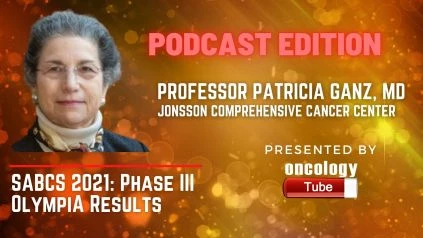Professor Patricia Ganz, MD, Director of Cancer Prevention and Control Research at the Jonsson Comprehensive Cancer Center speaks about the SABCS 2021 Abstract – GS4-09 Quality of life results from OlympiA: A phase III, multicenter, randomized, placebo-controlled trial of adjuvant olaparib after (neo)-adjuvant chemotherapy in patients with germline BRCA1/2 mutations and high-risk HER-2 negative early breast cancer.
Link to Abstract:
https://www.nejm.org/doi/full/10.1056/NEJMoa2105215
Link to Clinical Trials.gov:
https://clinicaltrials.gov/ct2/show/NCT02032823
a summary –
BACKGROUND:
By synthetic lethality, poly(adenosine diphosphate–ribose) polymerase inhibitors target tumors with deficiencies in homologous recombination repair. In individuals with BRCA1 or BRCA2 germline mutation–associated early breast cancer, new medicines are needed to prevent recurrence.
METHODS:
Patients with human epidermal growth factor receptor 2 (HER2)–negative early breast cancer, BRCA1 or BRCA2 germline pathogenic or likely pathogenic variants, and high-risk clinicopathological factors who had received local treatment and neoadjuvant or adjuvant chemotherapy were enrolled in a phase 3, double-blind, randomized trial. Patients were given either 1 year of oral olaparib or placebo at random (in a 1:1 ratio). Invasive disease–free survival was the primary outcome.
RESULTS:
Randomization was performed on a total of 1836 patients. At a predetermined event-driven interim analysis with a median follow-up of 2.5 years, the olaparib group had an invasive disease–free survival rate of 85.9% versus 77.1 percent in the placebo group (difference, 8.8 percentage points; 95 percent confidence interval [CI], 4.5 to 13.0; hazard ratio for invasive disease or death, 0.58; 99.5 percent confidence interval [CI], 0.41 to 0.82; P0.001). The olaparib group had an 87.5 percent distant disease–free survival rate compared to an 80.4 percent placebo group (difference, 7.1 percentage points; 95 percent CI, 3.0 to 11.1; hazard ratio for distant disease or death, 0.57; 99.5 percent CI, 0.39 to 0.83; P0.001). Olaparib was linked to fewer fatalities (59 and 86, respectively) than placebo (hazard ratio, 0.68; 99 percent CI, 0.44 to 1.05; P=0.02), but the between-group difference was not significant at an interim-analysis limit of a P value of less than 0.01. There were no additional major adverse events or adverse events of special interest in the safety data, which were consistent with established olaparib side effects.
CONCLUSIONS:
Adjuvant olaparib after completion of local treatment and neoadjuvant or adjuvant chemotherapy was associated with significantly longer survival free of invasive or distant disease than placebo in patients with high-risk, HER2-negative early breast cancer and germline BRCA1 or BRCA2 pathogenic or likely pathogenic variants. Olaparib had just a minor impact on patient-reported overall quality of life.

